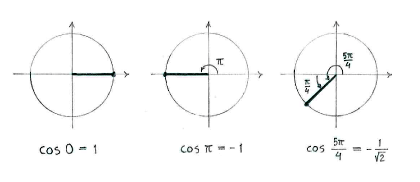Solution 2.1:4a
From Förberedande kurs i matematik 2
m (Lösning 2.1:4a moved to Solution 2.1:4a: Robot: moved page) |
m |
||
| (One intermediate revision not shown.) | |||
| Line 1: | Line 1: | ||
| - | + | If we draw the curve <math>y=\sin x</math>, we see that the curve lies above the ''x''-axis as far as <math>x=\pi </math> and then lies under the ''x''-axis. | |
| - | < | + | |
| - | + | ||
| - | + | ||
| - | < | + | |
| - | + | ||
| - | + | ||
[[Image:2_1_4_a1.gif|center]] | [[Image:2_1_4_a1.gif|center]] | ||
| + | |||
| + | The area of the region between <math>x=0</math> and <math>x=\pi</math> can therefore be written as | ||
| + | |||
| + | {{Displayed math||<math>\int\limits_{0}^{\pi} \sin x\,dx</math>}} | ||
| + | |||
| + | whilst the area of the remaining region under the ''x''-axis is equal to | ||
| + | |||
| + | {{Displayed math||<math>-\int\limits_{\pi}^{5\pi/4} \sin x\,dx</math>}} | ||
| + | |||
| + | (note the minus sign in front of the integral). | ||
| + | |||
| + | The total area becomes | ||
| + | |||
| + | {{Displayed math||<math>\begin{align} | ||
| + | & \int\limits_{0}^{\pi} \sin x\,dx - \int\limits_{\pi}^{5\pi/4} \sin x\,dx\\[5pt] | ||
| + | &\qquad\quad {}= \Bigl[\ -\cos x\ \Bigr]_0^\pi - \Bigl[\ -\cos x\ \Bigr]_\pi^{5\pi/4}\\[5pt] | ||
| + | &\qquad\quad {}= \Bigl( -\cos\pi - (-\cos 0)\Bigr) - \Bigl( -\cos\frac{5\pi}{4} - (-\cos\pi) \Bigr)\\[5pt] | ||
| + | &\qquad\quad {}= \Bigl( -(-1)-(-1) \Bigr) - \Bigl( -\Bigl(-\frac{1}{\sqrt{2}} \Bigr) - \bigl(-(-1)\bigr)\Bigr)\\[5pt] | ||
| + | &\qquad\quad {}= 1+1-\frac{1}{\sqrt{2}}+1\\[5pt] | ||
| + | &\qquad\quad {}= 3-\frac{1}{\sqrt{2}}\,\textrm{.} | ||
| + | \end{align}</math>}} | ||
| + | |||
| + | |||
| + | Note: A simple way to obtain the values of <math>\cos 0</math>, <math>\cos \pi </math> and <math>\cos (5\pi/4)</math> is to draw the angles <math>0</math>, <math>\pi</math> and <math>5\pi/4</math> on a unit circle and to read off the cosine value as the ''x''-coordinate for the corresponding point on the circle. | ||
| + | |||
[[Image:2_1_4_a2.gif|center]] | [[Image:2_1_4_a2.gif|center]] | ||
Current revision
If we draw the curve \displaystyle y=\sin x, we see that the curve lies above the x-axis as far as \displaystyle x=\pi and then lies under the x-axis.
The area of the region between \displaystyle x=0 and \displaystyle x=\pi can therefore be written as
| \displaystyle \int\limits_{0}^{\pi} \sin x\,dx |
whilst the area of the remaining region under the x-axis is equal to
| \displaystyle -\int\limits_{\pi}^{5\pi/4} \sin x\,dx |
(note the minus sign in front of the integral).
The total area becomes
| \displaystyle \begin{align}
& \int\limits_{0}^{\pi} \sin x\,dx - \int\limits_{\pi}^{5\pi/4} \sin x\,dx\\[5pt] &\qquad\quad {}= \Bigl[\ -\cos x\ \Bigr]_0^\pi - \Bigl[\ -\cos x\ \Bigr]_\pi^{5\pi/4}\\[5pt] &\qquad\quad {}= \Bigl( -\cos\pi - (-\cos 0)\Bigr) - \Bigl( -\cos\frac{5\pi}{4} - (-\cos\pi) \Bigr)\\[5pt] &\qquad\quad {}= \Bigl( -(-1)-(-1) \Bigr) - \Bigl( -\Bigl(-\frac{1}{\sqrt{2}} \Bigr) - \bigl(-(-1)\bigr)\Bigr)\\[5pt] &\qquad\quad {}= 1+1-\frac{1}{\sqrt{2}}+1\\[5pt] &\qquad\quad {}= 3-\frac{1}{\sqrt{2}}\,\textrm{.} \end{align} |
Note: A simple way to obtain the values of \displaystyle \cos 0, \displaystyle \cos \pi and \displaystyle \cos (5\pi/4) is to draw the angles \displaystyle 0, \displaystyle \pi and \displaystyle 5\pi/4 on a unit circle and to read off the cosine value as the x-coordinate for the corresponding point on the circle.


